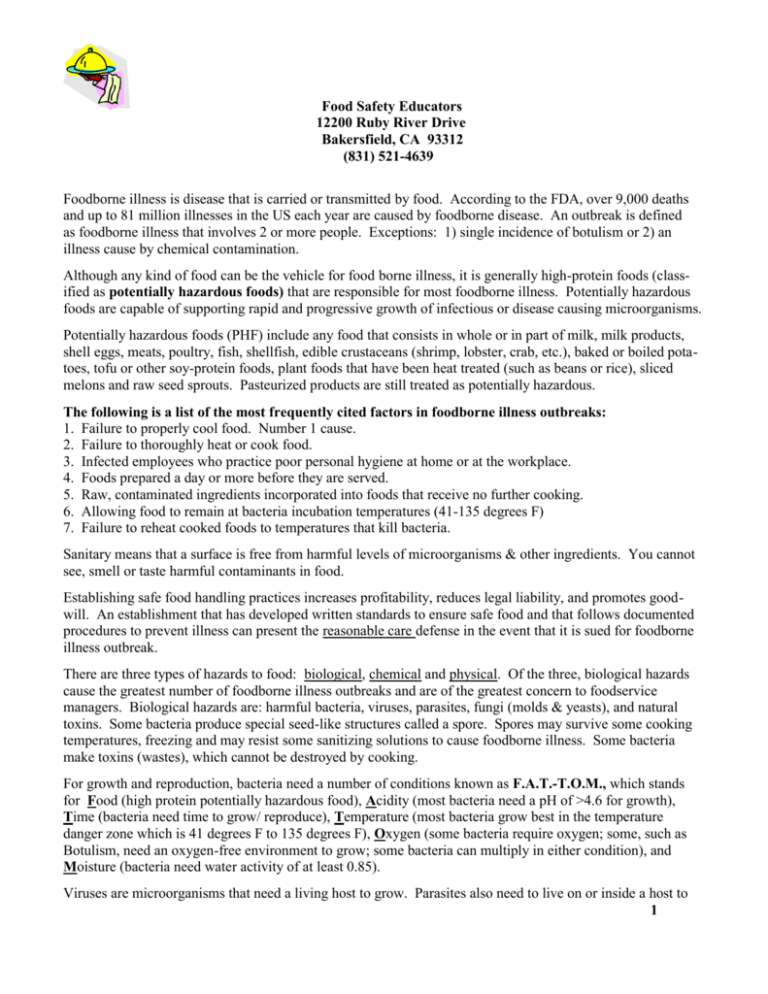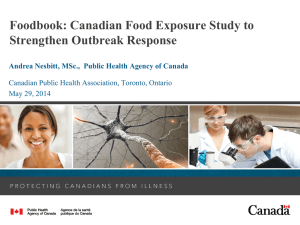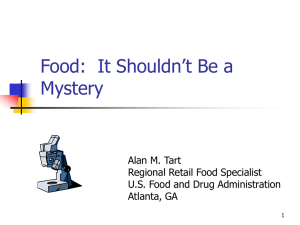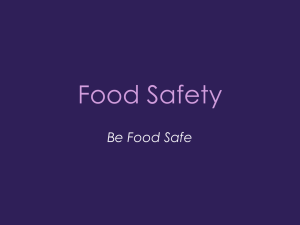Food Safety Educators 12200 Ruby River Drive Bakersfield, CA
advertisement

Food Safety Educators 12200 Ruby River Drive Bakersfield, CA 93312 (831) 521-4639 Foodborne illness is disease that is carried or transmitted by food. According to the FDA, over 9,000 deaths and up to 81 million illnesses in the US each year are caused by foodborne disease. An outbreak is defined as foodborne illness that involves 2 or more people. Exceptions: 1) single incidence of botulism or 2) an illness cause by chemical contamination. Although any kind of food can be the vehicle for food borne illness, it is generally high-protein foods (classified as potentially hazardous foods) that are responsible for most foodborne illness. Potentially hazardous foods are capable of supporting rapid and progressive growth of infectious or disease causing microorganisms. Potentially hazardous foods (PHF) include any food that consists in whole or in part of milk, milk products, shell eggs, meats, poultry, fish, shellfish, edible crustaceans (shrimp, lobster, crab, etc.), baked or boiled potatoes, tofu or other soy-protein foods, plant foods that have been heat treated (such as beans or rice), sliced melons and raw seed sprouts. Pasteurized products are still treated as potentially hazardous. The following is a list of the most frequently cited factors in foodborne illness outbreaks: 1. Failure to properly cool food. Number 1 cause. 2. Failure to thoroughly heat or cook food. 3. Infected employees who practice poor personal hygiene at home or at the workplace. 4. Foods prepared a day or more before they are served. 5. Raw, contaminated ingredients incorporated into foods that receive no further cooking. 6. Allowing food to remain at bacteria incubation temperatures (41-135 degrees F) 7. Failure to reheat cooked foods to temperatures that kill bacteria. Sanitary means that a surface is free from harmful levels of microorganisms & other ingredients. You cannot see, smell or taste harmful contaminants in food. Establishing safe food handling practices increases profitability, reduces legal liability, and promotes goodwill. An establishment that has developed written standards to ensure safe food and that follows documented procedures to prevent illness can present the reasonable care defense in the event that it is sued for foodborne illness outbreak. There are three types of hazards to food: biological, chemical and physical. Of the three, biological hazards cause the greatest number of foodborne illness outbreaks and are of the greatest concern to foodservice managers. Biological hazards are: harmful bacteria, viruses, parasites, fungi (molds & yeasts), and natural toxins. Some bacteria produce special seed-like structures called a spore. Spores may survive some cooking temperatures, freezing and may resist some sanitizing solutions to cause foodborne illness. Some bacteria make toxins (wastes), which cannot be destroyed by cooking. For growth and reproduction, bacteria need a number of conditions known as F.A.T.-T.O.M., which stands for Food (high protein potentially hazardous food), Acidity (most bacteria need a pH of >4.6 for growth), Time (bacteria need time to grow/ reproduce), Temperature (most bacteria grow best in the temperature danger zone which is 41 degrees F to 135 degrees F), Oxygen (some bacteria require oxygen; some, such as Botulism, need an oxygen-free environment to grow; some bacteria can multiply in either condition), and Moisture (bacteria need water activity of at least 0.85). Viruses are microorganisms that need a living host to grow. Parasites also need to live on or inside a host to 1 survive. Trichinella spiralis is the best known parasite that contaminates pork and game meats. The parasite Anisakiasis is harbored in raw or undercooked fish. Chemical hazards: harmful substances, such as cleaning solutions, sanitizers, metals and excessive amounts of food additives. Physical hazards: foreign particles such as glass or metal particles and jewelry. A food service establishment must maintain multiple barriers to foodborne hazards, for example, in making a protein salad, one of the barriers to bacterial growth is using chilled commercial mayonnaise, rather than homemade. The acidity of the commercial mayonnaise helps make it less favorable for bacterial growth. Chilling the mayonnaise (and other salad ingredients) ensures that the salad will spend less time in the temperature danger zone. A foodborne infection is a disease that results from eating food containing living harmful microorganisms. A foodborne intoxication results when toxins, or poisons, from bacterial or mold wastes or chemicals are in food. These toxins are generally odorless and tasteless and are capable of causing disease even after the microorganisms have been killed. Salmonellosis: (infection) Salmonella are found in animals especially poultry, eggs, in pets such as turtles, kittens and ducklings and in humans. When preparing products containing eggs that will not be thoroughly cooked, such as hollandaise sauces, Caesar salad dressings, meringues, and mousses, use frozen or liquid pasteurized eggs or commercially prepared mixtures. Do not serve undercooked shell eggs. Shigellosis: (infection) Humans are the prime reservoir for Shigella. Carriers excrete Shigella in their feces. When they fail to wash their hands properly they transmit the bacteria to food. Listeriosis: (infection) raw soil-grown vegetables can be contaminated. Dairy products, especially unpastuerized milk and certain soft cheeses, raw meats, and poultry have been implicated in outbreaks of Listeriosis. The death rate for non-pregnant adults averages 30%. Staphylococcal food intoxication: Staphylococcus is most commonly found in the nasal passages, on hands and skin, infected eyes and ears, in and around boils, pimples, carbuncles, inflamed cuts and burns. Bacillus cereus: (intoxication) found in soil. Spores are found in grains, rice, flour, spices, starches and drymix products. Clostridium perfringens: (foodborne toxin-mediated infection) bacteria and spores found in soil, dust and human and animal feces. Hepatitis A: a highly contagious viral infection. While usually not fatal, it can make someone extremely ill for months. A person can be a carrier (show no symptoms) for up to 50 days. Vaccination is the only reliable control measure. Campylobacter jejuni: (infection) insufficiently cooked meat and poultry, unpasteurized dairy products, and foods that have been cross-contaminated. Escherichia coli 0157:H7(infection/intoxication): raw or undercooked ground beef and red meats are main vehicles of transmission. Cook ground meat thoroughly to a minimum internal temperature of 155 degrees F. E coli 0157:H7 kills hundreds of children in the USA each year. Ciguatera (fish toxin) is not destroyed by cooking. Control: make sure that fish is acquired from a reputable seafood supplier. 2 If food service chemicals are transferred to smaller containers or spray bottles, each new container must be properly stored and labeled with the contents and hazards. Material Safety Data Sheets (MSDS) are required by law for each chemical in the establishment. The MSDS must have chemical name, physical hazards, health hazards and emergency procedures in case of exposure. The most important aspect of personal hygiene is frequent and thorough hand washing. Wash hands well for at least 20 seconds. Wash hands often, after touching anything that is not sanitary. Gloves are not a substitute for proper hand washing and safe food handling practices. You must change your gloves after touching anything that may contaminate them and wash your hands. Keep nails clean and trimmed. Wounds and open sores must be antiseptically bandaged. Bandages on the hand must be covered with waterproof, disposable, plastic gloves that will protect food as well as the food handler. In some cases the employee may need to move to a non food handling job until the injury heals. Exclude employees who are ill from handling duties. HACCP - Hazard Analysis Critical Control Point food safety system. A critical Control point (CCP) is an operation (practice, preparation, step or procedure) by which a preventive or control measure can be applied that would eliminate, reduce or prevent a reasonably likely biological, chemical or physical food hazard. 7 major principles involved in a HACCP system: 1. Assess hazards at each step in flow of food and develop procedures that control reasonably likely hazards. 2. Identify Critical Control Points. (CCPs) 3. Set up control procedures and standards for each CCP. 4. Monitor CCPs (example: keep temperature logs). 5. Take corrective actions if there is a break from procedures set up as CCPs. 6. Develop record keeping system that documents the HACCP plan. 7. Verify that HACCP system is working. CCPs must be observable and measurable. An example of monitoring a CCP may be in checking temperature with a correctly calibrated clean and sanitized thermometer and recording the temperature. Verify/study time and temperature logs. Record errors and corrective actions taken in order to evaluate your program, and detect dry lab (the entering of data without taking measurements). The thermometer can be the single most effective tool in the protection of food. The most common type of thermometer is the bi-metallic stemmed thermometer, which must be numerically scaled, accurate to within +/- 2 degrees F and have a calibration nut so that it can be adjusted to maintain accuracy. A bi-metallic stemmed thermometer with a plastic lens cover should not be left in food during cooking in an oven, microwave or stovetop range. Mercury filled or other glass thermometers should never be used to measure food temperatures because they can break. Always take the temperature in the geometric center of food (the thickest part). Vacuum packaging will not stop the growth of bacteria in food. Check the temperatures of modified atmosphere packaging (MAP) foods by holding thermometer tightly between 2 packages being careful not to puncture or break wrapping. When open, shelf life deteriorates quickly. Check with manufacturer for use by date. Receiving is a CCP for MAP, vacuum packed or sous vide packages. In receiving, an unacceptable fish presents gills that are dark and dull red, brownish or gray and/or cloudy eyes. 3 Storing raw foods below cooked foods or foods that receive no further cooking, and covering foods helps prevent cross contamination of refrigerated foods. Ideal temperature for most goods placed in dry storage is 50 degrees F, and with a relative humidity of 5060%. The temperature danger zone is from 41 degrees F to 135 degrees F. Most rapid growth of bacteria occurs within this range. When potentially hazardous foods are heated or cooled, pass these foods through the temperature danger zone as quickly as possible. The exposure time adds up with each stage of handling and serving. It starts with receiving and storing, and continues through preparation, holding, serving, cooling and reheating. Food should not be in the danger zone for more than 4 hours total (cumulative). Acceptable ways to thaw food: - Safest way: under refrigeration (< 41 degrees F). Refrigeration is the only safe way to thaw large foods such as a turkey. - Under potable (drinkable) running water at 70 degrees F or below if food is small enough. - In a microwave oven, but only if food will be transferred immediately to conventional cooking or if the entire uninterrupted cooking process takes place in microwave. Whatever cooking method is selected, reduce the risk that bacteria will survive by cooking food to an internal temperature that will ensure its safety. The following recommended temperatures are minimum temperatures that must be reached for at least 15 seconds: - Poultry, stuffed meats and stuffed pastas - 165 degrees F - Ground beef and ground pork - 155 degrees F - Pork, ham and sausage, and bacon (any food with pork) - 145 degrees F - All other potentially hazardous foods (including fish and single eggs) 145 degrees F Exception: rare roast beef can be cooked at 130 degrees F for over 2 hours. - If using microwave, add 25 degrees F higher than conventional oven cooking temperatures. The internal cooking temperatures should be checked in several places. Food bars: employees handing out fresh clean plates for return visits to food bar discourage customers from reusing their soiled plates. Reusing plates contributes to increased risk of foodborne illness outbreaks. Proper design of self service areas should contain sneeze guards/food shields over display counters and salad bars; salad dressings should be identified and individual long handled scoops provided so customers do not stick fingers in to taste. Rotate foods on a frequent basis and do not mix replacement foods with foods on the food bar. Cooked foods should be chilled to internal temperature of 41 degrees F rapidly. The thickness or distance to center of food mass has greatest influence on cooling rate. To cool it fast, reduce the mass-cut large roasts into smaller pieces, use ice water baths (stir frequently). Cooling paddles are also effective in cooling hot foods. You can also chill foods in shallow pans that are no more than four inches deep with product depth of no more than two inches on the top shelf of the refrigerator. DO NOT STACK PANS! Rapidly reheat previously cooked foods, such as beef stew that has been refrigerated, to a minimum of 165 degrees F. (190 degrees F in a microwave). Avoid cross contamination from raw to cooked and ready to eat food via hands, equipment and utensils. Clean and sanitized food contact surfaces after every use, or after 4 hours of continuous use. The layout of a foodservice establishment must reduce the chances of food contamination and cross contamination. Equipment must have NSF or UL markings. Copper, or brass must not be used with food that has a pH below 7. Galvanized metal may not be used for food contact surfaces. 4 The only completely reliable backflow prevention device is the air gap. The air gap is an unobstructed, vertical distance through the air that separates an outlet of potable water supply from any potentially contaminated water. All surfaces coming into contact with food (plates, pots, tables, utensils, trays, or potato peelers) must be washed, rinsed and sanitized after every use, after any interruption during which contamination could occur and at regularly scheduled intervals if they are in constant use. Use test kits or strips to make sure that the concentration of chemical sanitizers are correct. Recommended concentration levels for chemical sanitation agents: Chlorine - 50 to 100 parts per million (ppm) Iodine 12.5 to 25 ppm Quaternary ammonium (quats) - 200 to 220 ppm or per manufacturers instructions. Hot water sanitizing by machine - the temperature of the water for final rinse must be at least 180 degrees F but no higher than 195 degrees F. Steps for manual immersion washing in sinks: 1. Clean and sanitize sinks and work surfaces before each use. 2. Scrape and pre-soak. 3. Wash in first sink using clean detergent solution at 120 degree F. 4. Rinse in second sink using clear potable water at 120 degrees F. All food and detergent must be removed or it will interfere with effectiveness of sanitizing agent. 5. Sanitize in third sink by immersing items in a chemical sanitizing solution according to manufacturers instructions. 6. Air dry - DO NOT WIPE DRY. The process of air drying is part of sanitizing. When devising a master cleaning schedule, make sure the following is stated for each item to be cleaned: What is to be cleaned; who is to clean the item by job title; when it is to be cleaned, and how the job is to be done. IPM - Integrated Pest Management is a system that combines preventive tactics with control measures to reduce pest infestation. The IPM approach that includes: correcting sanitary procedures, non-chemical solutions, sealing cracks and crevices and chemical treatments. Pesticides should be a last resort and should only be applied by PCO (Pest Control Operator). One of the most important roles of a manager is to set an example by his or her own behavior and attitudes for all employees to follow. When conducting one-on-one training, make sure that the new employee does not learn any bad habits from the other employees. You must find ways to motivate the group to want to learn what you are teaching. Suggestions: - Use entertaining training materials and vary those materials. - Recognize employee achievements. - Maximize employee participation during sessions. AIDS is not a foodborne illness. Just because someone is HIV positive, does not mean that they should not work in foodservice. All foodservice operations should have people trained in the Heimlich Maneuver (first aid for choking) and CPR. 5







